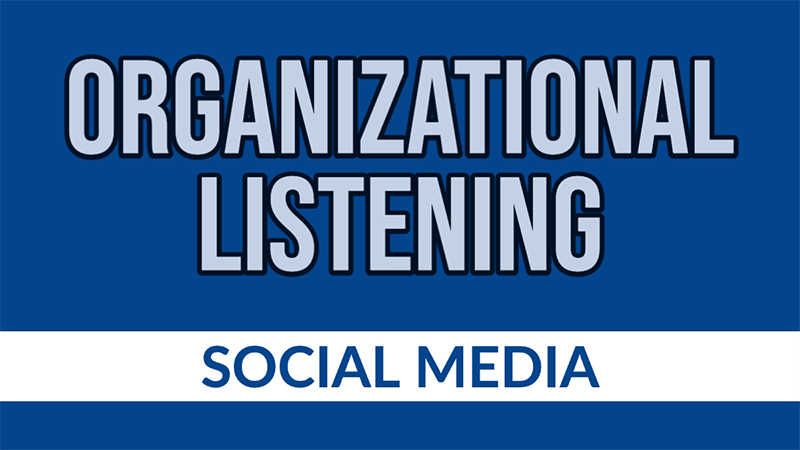Attention social media managers! Stakeholders expect you to listen
August 27, 2021

By Sarah Maben and Chris Gearhart, Tarleton State University
Truly listening to stakeholders in social media, and not just surveilling them for marketing preferences and trends, requires proof of listening. That means putting listening into action through a response such as a like, reply, favorite, heart, gif, or emoji.
Social media opened organizations up to two-way communication possibilities for stakeholder communication, but the amount of concurrent conversation on all your social channels is overwhelming. With so many potential conversations, we devised an experiment to see what followers really expect when they tag a company or contact them through social media channels.
First off, one fact we found is that what they want isn’t groundbreaking news: They simply want a response. But about half of those surveyed (48.5 percent) said they had tried contacting an organization on social media (130 people) and are still waiting for a response. They wrote in their comments:
"It's nice to get a response and to feel heard. If I don't receive a response, I feel less heard and I'm less likely to use/order from that company in the future."
"Whether or not the response is what I'm hoping to hear, at least someone takes the time to respond and that is most important."
Your organization can do better than just responding, although that’s a start. Some responses are better than others and that is what we wanted to investigate. We asked survey takers to evaluate sample responses for scenarios as if they were the stakeholder who contacted an organization using social media.
Below you'll see a sample scenario. Think of all the ways ArkVet could respond. If they don’t respond, does the stakeholder know they listened?

What we found after surveying 299 social media users in the United States:
• 43 percent had contacted an organization using social media
• 82 percent of those receiving a response said the organization met or exceeded their expectations
• Half of them did not receive a response or any proof of listening
• Top motivations for contacting an organization were
- To get a question answered
- To get help or resources
- To give thanks
- Responses that exhibit a high level of action and empathy are believed to be more appropriate and effective. This was especially true for service complaint situations.
• About a third said gifs, memes, and emojis would be appropriate in organizational responses. Another third was neutral and the last third said those graphical messages would be inappropriate.
In addition, we asked the survey takers to tell us about a specific instance where they reached out to an organization via social media. We reviewed their stories for themes and takeaways. Here’s what we learned; stakeholders want organizations to
- Respond to questions in a timely manner. (And timely is a relative term. If they are asking about when a bar closes, they need to know now, not the next morning.)
- Be clear about what they need when a complaint is made.
- Provide an incentive (discount for product or service) for good feedback.
- Respond even if they don't have the answer they are looking for.
Competent listening translates in organizational social media. Active and empathetic listeners are considered competent listeners. They acknowledge feelings and get things done. These techniques, from interpersonal interactions, translate to organizational listening in social media.
What can organizations do to enhance their listening practices?
Organizations can further develop their social media plans to include listening and response metrics and expectations. If social media response teams see themselves as the listening agents for the organization, essentially a bridge to stakeholders, they may approach responses in a different light. Using active-empathic listening techniques, organizations can bolster the listening piece in stakeholder dialog. Some ways organizations can do this is by
- Asking questions that continue the dialog
- Follow-up with stakeholders after the fact
- Provide additional information to supplement what was requested
- Acknowledge feelings expressed or implied by followers
Also, using A/B testing on your posts can help better tailor your listening and the use of graphics (emojis, gifs, etc.) to your stakeholders. Adjusting policies will be necessary to match and exceed stakeholder expectations for listening. If emojis work well for positive messages for your organization, then make sure your social media team is not constrained by an out-of-date manifesto about what constitutes a proper post.
From our research, organizations are satisfying stakeholders but can be more responsive, strategic and competent. Taken as part of the larger call for listening research, the Page Center is driving a much-needed conversation and investigation into listening as it relates to organizational communication.
For more information on this study, email Maben at maben@tarleton.edu or Gearhart at gearhart@tarleton.edu. This study is a part of the Center's 2020 Page/Johnson Legacy Scholar Grants call for research proposals focusing on organizational listening. Graduate students Amme O’Grady and Jessica Pounds contributed to this research project.

